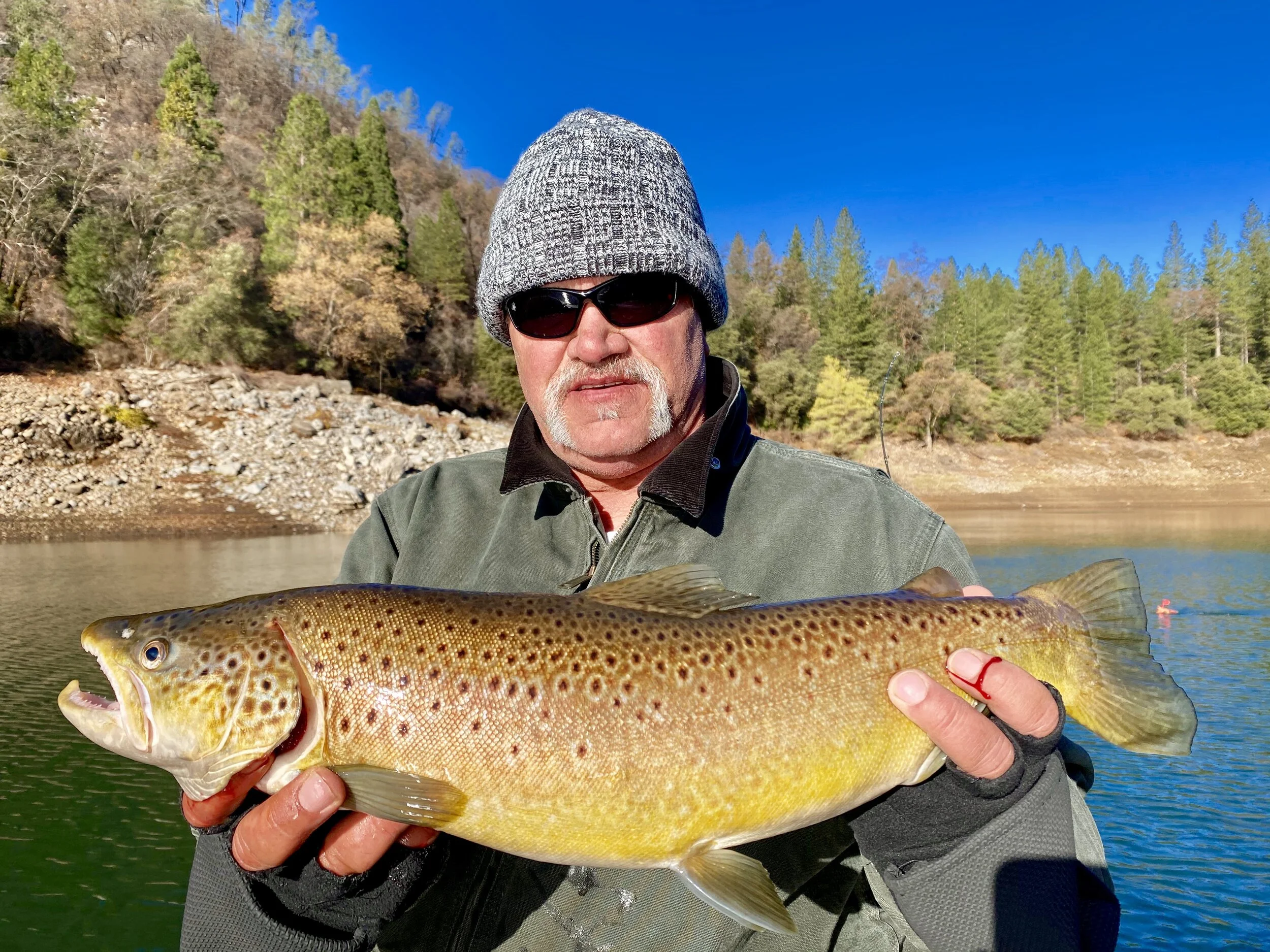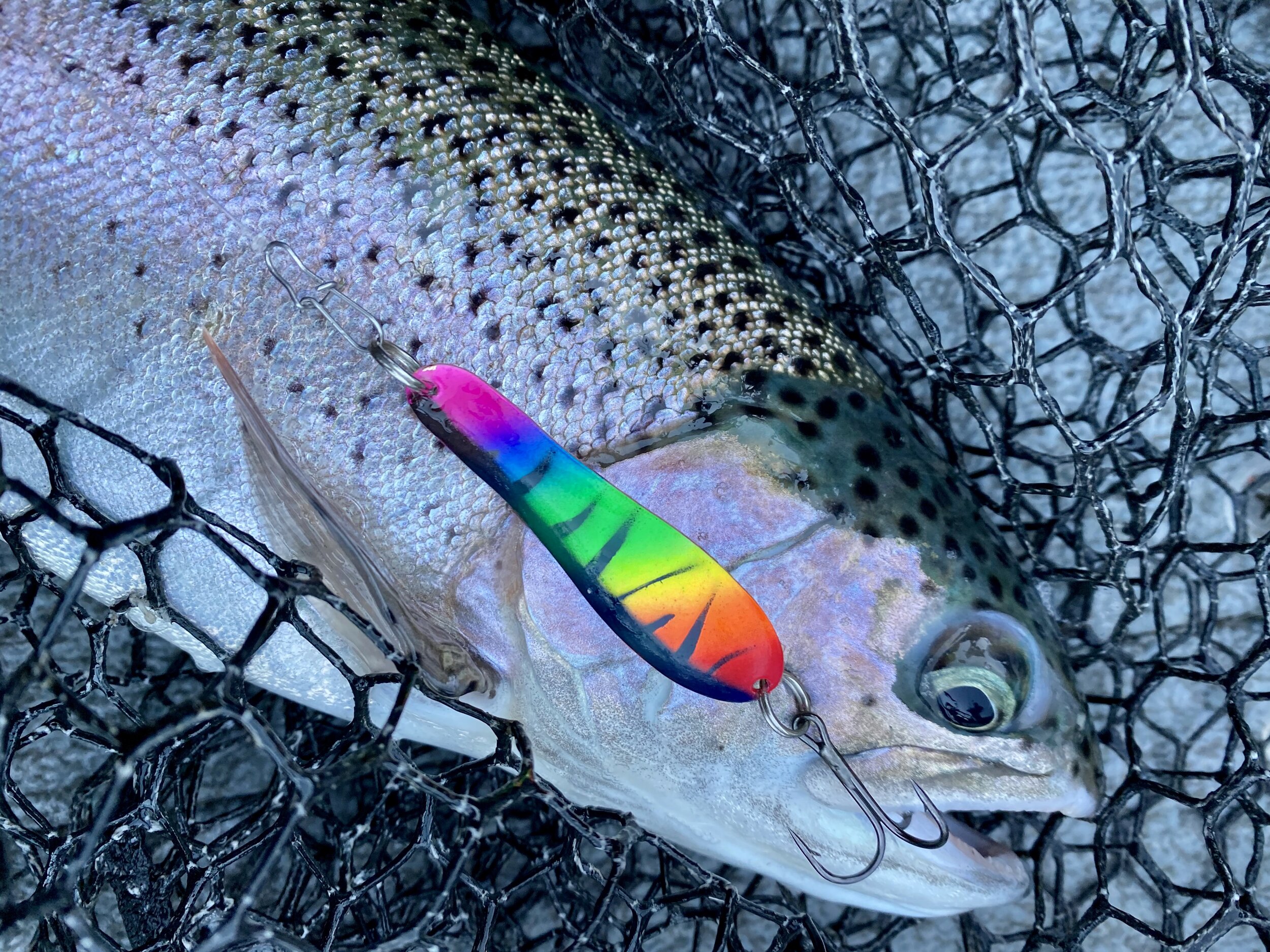Fall changes on Shasta Lake are guaranteed in December
Fishing Shasta Lake in December can be both very cold and wet! December brings with it a change in the seasons and Shasta Lake fills its full potential for the winter season. While October and November tend to be the beginning of change after the summer season on Shasta Lake, December is when we start to see some significant changes to this large body of water. Lake levels will be on the rise and any amounts of rain will keep the lake on its fall/winter rise. Colder evening temperatures and the influx of rain water runoff will set the stage for the lakes winter turn over which normally happens in late December. Any body of water that experiences significant changes will definitely affect the fish species contained within its mass. Continued changes to lake will dictate the fishing patterns and techniques we deploy when fishing Shasta Lake every December. The following information comes from my own personal experiences while fishing Shasta Lake during this time of the year.
A Trinidad Tackle Optimizer Jr trolled far behind the boat off a downrigger tricked this fall trout into biting.
WHERE TO FISH ON SHASTA LAKE DURING THE MONTH OF DECEMBER
I’ll be the first to admit that fishing Shasta Lake in December can be pretty tough, but not like we see in October. Staying on top of the fishing pattern is pretty important and that means spending a lot of days figuring out where the trout are hanging out. It should be understood that rainbow trout, unlike the brown trout, will hang out in certain areas of the lake for a period of time, but will often move to another part of the lake without proper notice to the anglers that pursue them. This can be very frustrating and have you second guessing yourself for days on end.
Two patterns that the trout in Shasta Lake seem to stay true to is, browns hold on or near structure, and rainbows will hold shallow over the deeper sections (channels) of the lake. Browns are territorial to specific areas of the lake and rainbows simply put, are nomadic. Trolling side planers is a great way to cover the areas that browns will hold close to shore, and over the deeper water sections of the lake. In the picture below the three side planers are running lures closer to shore on the left side of the boat, and the side planers on the right side of the boat are running lures over water that is quite deep. Its hard to beat this technique for covering the water that will hold two different trout species simultaneously. Simply put, cover structure and open water to catch trout on Shasta Lake in December.
Working the shorelines with side planers in December is deadly!
TROLLING TECHNIQUES FOR TROUT ON SHASTA LAKE IN DECEMBER
There are many techniques used to troll on Shasta Lake in the fall, but I favor trolling in the upper 10-15’ of the water column in December every year. Two things to consider are where you want to troll for browns and rainbows, and how do you keep from spooking the bigger, more weary fish when trolling up so high in the water cold water column. Big fish are known to be boat shy and so are the smaller trout for the most part.
One of the very best techniques for finding and catching big trout on Shasta Lake during the cold water months is the use of inline side planers. Top lining the surface and having really long setbacks using downriggers (200’+) can be somewhat effective, but not nearly as effective as side planers. It should be noted that there are times when aggressive trout will be attracted to the prop wash from your trolling motor and will come up to hit lures trolled in this section of disturbed water behind the boat.
You can use any number of ways to get the lines down a bit deeper straight behind the boat, but this technique is where snap weights or Torpedo weights will shine. I like to run the rods off the back of the boat deeper to avoid being too close to the boat and to make room for bring in hooked fish behind the boat to net. Shallow lines off the transom will almost always get tangles with other lines when fighting hooked trout to the back of the boat. Remember, side planers can be positioned as far away from the trolling path of your boat as you want and you can run 1-3 lines off each side of the boat very easily. Having 6 lines or more in the water and covering over a 100’ wide section of the lake all at once can be extremely effective when fishing for big trout. The presence of your boat becomes a non factor and you can present lures in places you simply can’t when trolling directly behind the boat. This is especially true when you are targeting big browns that are laying on structure, like big points and steep walls. As an example, big browns will often times hang out on big points in shallow water in December. You can very efficiently run a few side planers right over those areas holding fish with a lure setback of 50’ to 150’ behind the side planer.
In December, I’ll use weighted lines off the side planers to get the lures down a bit, but not a lot. Two colors of lead core line or an ounce or two of lead on a snap weight is about all you’ll need to get into the strike zone. Running side planers is a quiet presentation with very little disruption to the surface when trolling over those big, weary browns and rainbows compared to driving over the top those same fish with your boat. A dynamic thats often un noticed when running side planers is the action that the side planers impart on your trolled lures. On choppy surface days, theres no better way to take advantage of the action the chop gives the side planers and subsequently imparts on the trailing lures. I think by now my point regarding the benefits of side planers when trolling on lakes has been made. I have a few other tricks up my sleeve to talk about, but I have all winter to talk about them in upcoming articles.
Wet and very cold winter day on Shasta Lake trolling with both side planers and downriggers.
LURES WE USE TO CATCH BIG TROUT IN DECEMBER
There are dozens and dozens of lures you can use to catch December trout on Shasta Lake, but if I had to choose one, it would be a Trinidad Tackle Optimizer or Optimizer Jr. spoon. Its been proven time and time again that these spoons will catch big Shasta Lake trout. I really like the action that the Brad’s Kokanee Cut Plugs have and the option to stuff them with bait has its advantages. I started using the a lot last year and after some trial and error, I started catching some great trout. They are a favorite for catching Kings on Shasta, but I’ll talk more about how I fish them in a little closer to spring when we start to target King and Kokanee salmon.
I have previously written an article surrounding the use of trolling flies for trout on Shasta Lake and its had thousands of readers since I wrote it a few years ago. Flies are deadly when trolling for trout on Shasta so taking the time to read that article is very much worth your time. Flies can be trolled with any other presentation at the same time which makes them one of the most versatile attractors for trout known to mankind.
FINAL THOUGHTS FOR FISHING SHASTA LAKE IN DECEMBER
I know this information will be helpful to some and I truly hope to see some of this information put to use by the readers of this article. It doesn’t contain every piece of the puzzle, but the puzzle pieces change every month of the year. Some of the biggest trout, especially brown trout, are caught during December each year and the rainbow trout fishing can be pretty good as well. I wish all of you the best of luck and hope to see some amazing Shasta Lake trout pic’s again this year.
My next article will contain a few different insights on how to fish Shasta Lake during the month of January. As with December, January will surely bring more changes to Shasta Lake and my approach to fishing it will change as well.
Captain Jeff Goodwin
9 Likes






